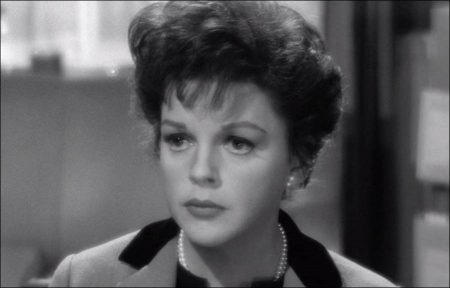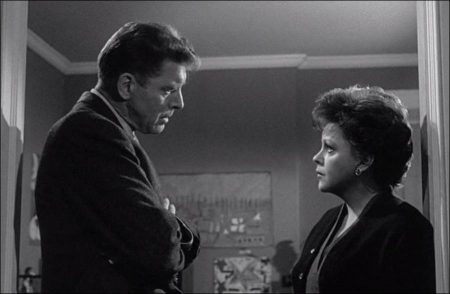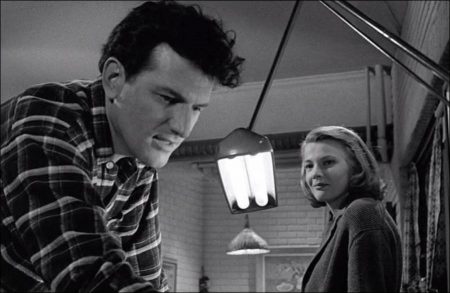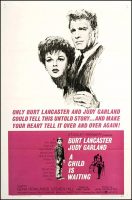A Child is Waiting movie storyline. Psychologist Dr. Matthew Clark (Burt Lancaster) is the head of the Crawthorne State Training Institute, one of the first boarding schools for developmentally challenged children. Dr. Clark is sympathetic but demanding of his teachers and students. His approach of tough love is controversial. He takes a chance at hiring former aspiring concert pianist Jean Hansen (Judy Garland) as the school’s music teacher, Miss Hansen who has no background in nursing, teaching or dealing with the developmentally challenged.
She herself is trying to find her own place in life. She immediately bonds with autistic student Reuben Widdicombe, who she sees as needing special attention in light of his parents having not visited him since they enrolled him in the school two years earlier. The Widdicombes divorced shortly thereafter because of the pressures their relationship faced in dealing with Reuben.
Dr. Clark sees Reuben as the type of child the most difficult with which to deal: Reuben understands just enough to realize that he is different and is often being rejected. Miss Hansen and Dr. Clark disagree on how best to get through to Reuben. Although Dr. Clark admits that his methods have not worked with Reuben, he also does not believe that Miss Hansen’s approach of undivided attention is the answer. Through getting to know the Widdicombe’s reasons for not visiting and she herself seeing the life of the adult disabled, Miss Hansen comes to an understanding of how she feels she can best help her students, Reuben included.
A Child Is Waiting is a 1963 American drama film written by Abby Mann based on his 1957 Westinghouse Studio One teleplay of the same name. The film was produced by Stanley Kramer and directed by John Cassavetes. Burt Lancaster portrays the director of a state institution for mentally handicapped and emotionally disturbed children, and Judy Garland is a new teacher who challenges his methods.

About the Production
Producer Stanley Kramer modeled the film’s school on the Vineland Training School in New Jersey. He wanted to bring the plight of mentally and emotionally disturbed children to the movie-going public and try “to throw a spotlight on a dark-ages type of social thinking which has tried to relegate the subject of retardation to a place under the rocks.”
He wanted to cast Burt Lancaster because the actor had a troubled child of his own (his son Bill had polio that made one of his legs shorter than the other). Ingrid Bergman, Katharine Hepburn, and Elizabeth Taylor were considered for the role of Jean Hansen, which went to Judy Garland, who previously had worked with Lancaster and Kramer on the 1961 film Judgment at Nuremberg. She was experiencing personal problems at the time and the director felt a supportive work environment would help her get through them.
When original director Jack Clayton was forced to withdraw due to a scheduling problem, he was replaced by John Cassavetes, who was still under contract to Paramount Pictures, on the recommendation of screenwriter Abby Mann. Cassavetes was fond of improvisation and his approach to filmmaking clashed with those of Kramer and the leading players.
Most of the students in the film were portrayed by actual mentally-challenged children from Pacific State Hospital in Pomona, California. After the film’s release, Kramer recalled, “They surprised us every day in reaction and what they did.” Lancaster said, “We have to ad-lib around the periphery of a scene and I have to attune and adjust myself to the unexpected things they do. But they are much better than child actors for the parts. They have certain gestures that are characteristic, very difficult for even an experienced actor.”
Problems arose between Kramer and Cassavetes during post-production. Editor Gene Fowler, Jr. recalled, “It was a fight of technique. Stanley is a more traditional picture-maker, and Cassavetes was, I guess, called Nouvelle Vague. He was trying some things, which frankly I disagreed with, and I thought he was hurting the picture by blunting the so-called message with technique.”
Cassavetes felt his personal feelings about the subject matter added to the disagreements between himself and Kramer, who eventually fired the director. In a later interview, Cassavetes said, “The difference in the two versions is that Stanley’s picture said that retarded children belong in institutions and the picture I shot said retarded children are better in their own way than supposedly healthy adults.
The philosophy of his film was that retarded children are separate and alone and therefore should be in institutions with others of their kind. My film said that retarded children could be anywhere, any time, and that the problem is that we’re a bunch of dopes, that it’s our problem more than the kids’. The point of the original picture that we made was that there was no fault, that there was nothing wrong with these children except that their mentality was lower.”
Cassavetes disowned the film, although following its release he said, “I didn’t think his film – and that’s what I consider it to be, his film – was so bad, just a lot more sentimental than mine.” Kramer observed, “My dream was to jump the barrier of ordinary objection to the subject matter into an area in which the treatment of it and the performance of it would be so exquisite that it would transcend all that. Somewhere we failed.”
A Child is Waiting (1963)
Directed by: John Cassavetes
Starring: Burt Lancaster, Judy Garland, Gena Rowlands, Steven Hill, Lawrence Tierney, Bruce Ritchey, John Marley, Paul Stewart, Elizabeth Wilson, Barbara Pepper, Billy Mumy, Juanita Moore
Screenplay by: Abby Mann
Production Design by: Rudolph Sternad
Cinematography by: Joseph LaShelle
Film Editing by: Gene Fowler, Jr., Robert C. Jones
Set Decoration by: Joseph Kish
Music by: Ernest Gold
MPAA Rating: None.
Distributed by: United Artists
Release Date: February 13, 1963
Visits: 221


